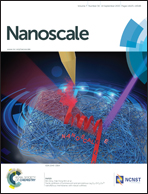Freestanding eggshell membrane-based electrodes for high-performance supercapacitors and oxygen evolution reaction†
Abstract
A type of freestanding, light-weight eggshell membrane-based electrode is demonstrated for supercapacitors and for oxygen evolution reaction (OER) catalysis. As a widely available daily waste, eggshell membranes have unique porous three-dimensional grid-like fibrous structures with relatively high surface area and abundant macropores, allowing for effective conjugation of carbon nanotubes and growth of NiCo2O4 nanowire arrays, an effective supercapacitor material and OER catalyst. The three-dimensional fibrous eggshell membrane frameworks with carbon nanotubes offer efficient pathways for charge transport, and the macropores between adjacent fibers are fully accessible for electrolytes and bubble evolution. As a supercapacitor, the eggshell membrane/carbon nanotube/NiCo2O4 electrode shows high specific capacitances at current densities from 1 to 20 A g−1, with excellent capacitance retention (>90%) at 10 A g−1 for over 10 000 cycles. When employed as an OER catalyst, this eggshell membrane-based electrode exhibits an OER onset potential of 1.53 V vs. the reversible hydrogen electrode (RHE), and a stable catalytic current density of 20 mA cm−2 at 1.65 V vs. the RHE.


 Please wait while we load your content...
Please wait while we load your content...